仁爱版英语九年级下Unit 5 Topic 1 .Section A课件(42张PPT无音视频)
文档属性
| 名称 | 仁爱版英语九年级下Unit 5 Topic 1 .Section A课件(42张PPT无音视频) |  | |
| 格式 | zip | ||
| 文件大小 | 4.2MB | ||
| 资源类型 | 教案 | ||
| 版本资源 | 仁爱科普版 | ||
| 科目 | 英语 | ||
| 更新时间 | 2020-06-07 23:23:58 | ||
图片预览

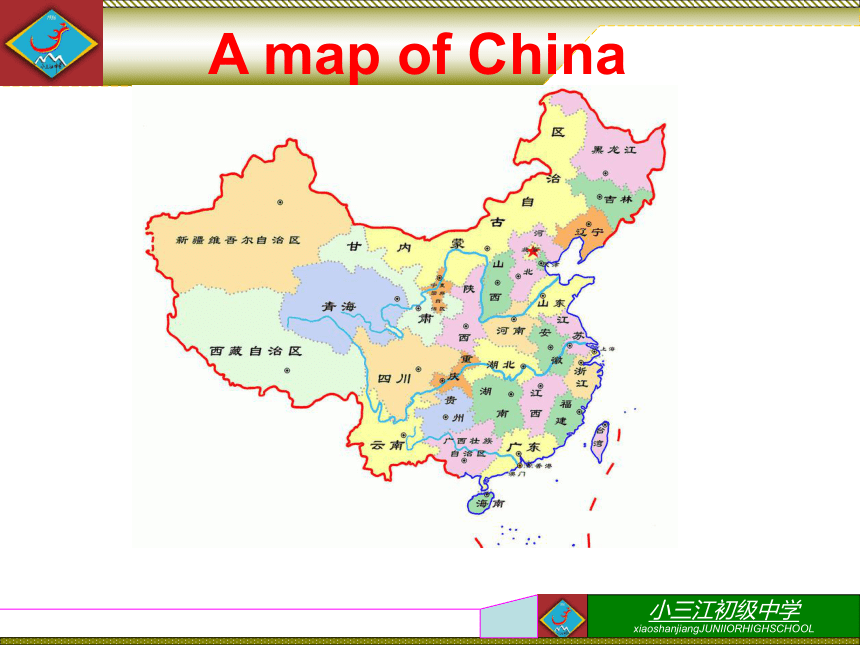
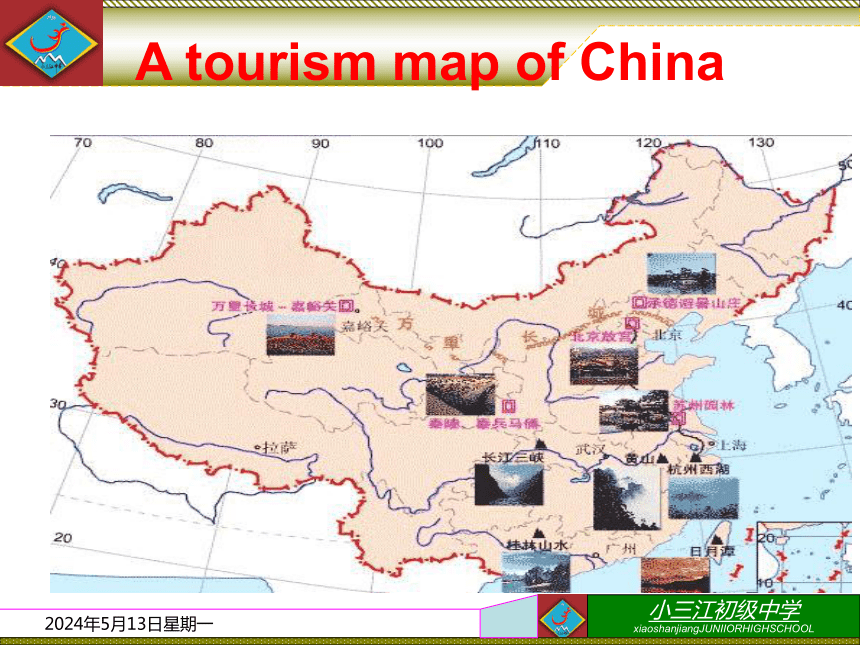
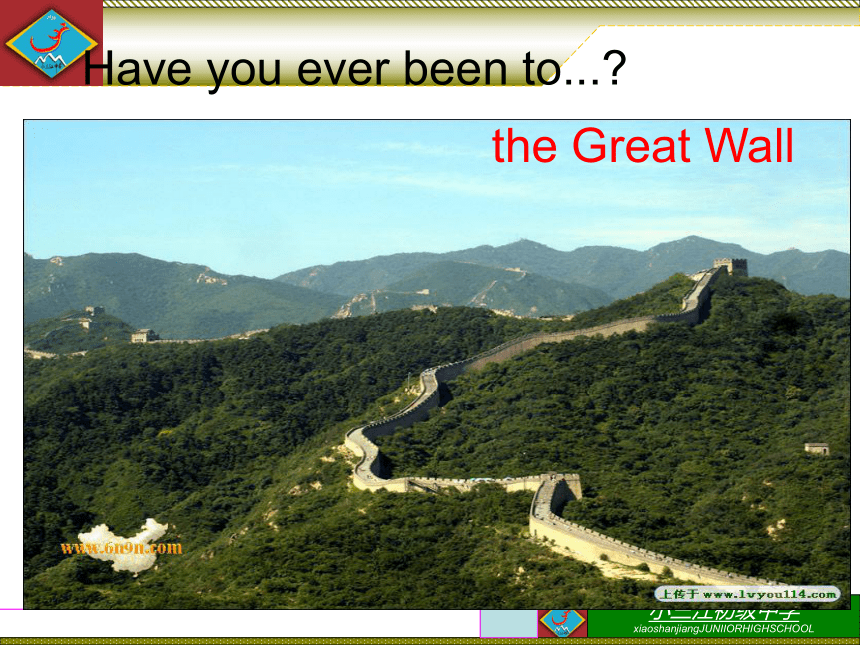
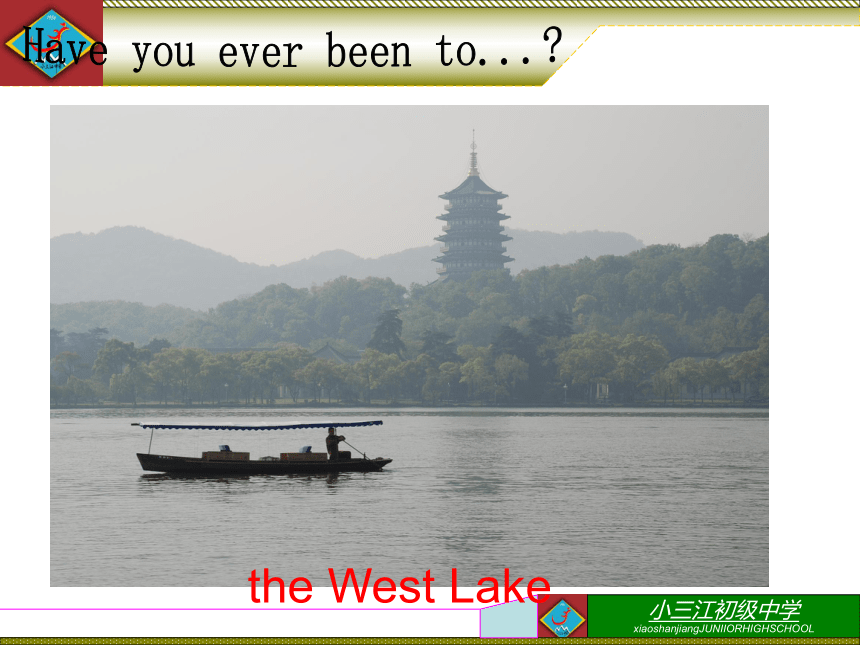

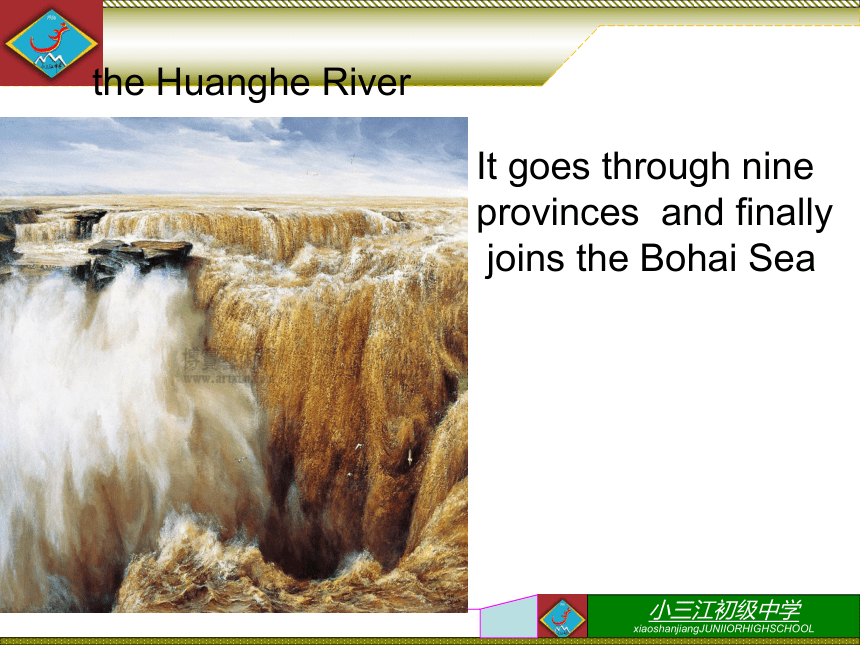
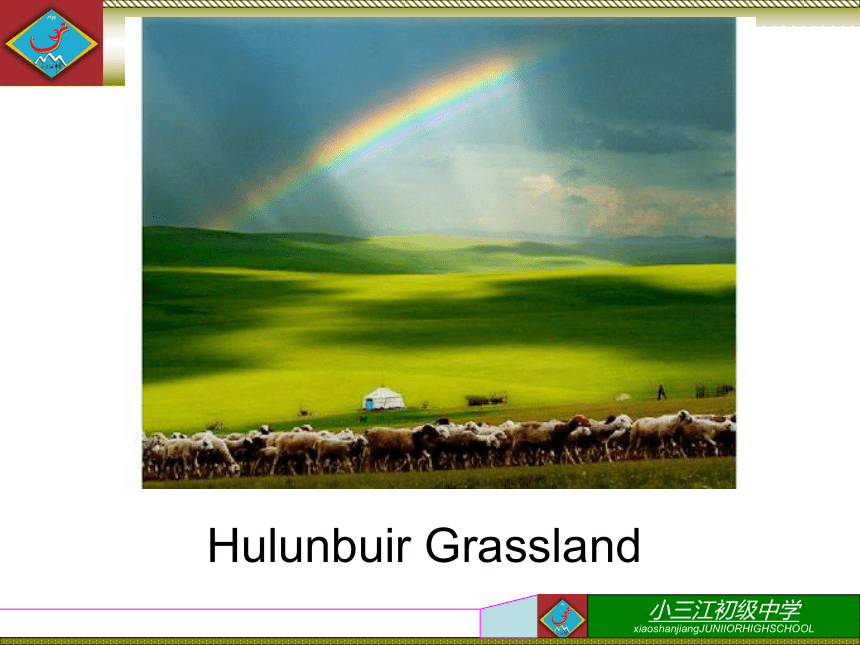



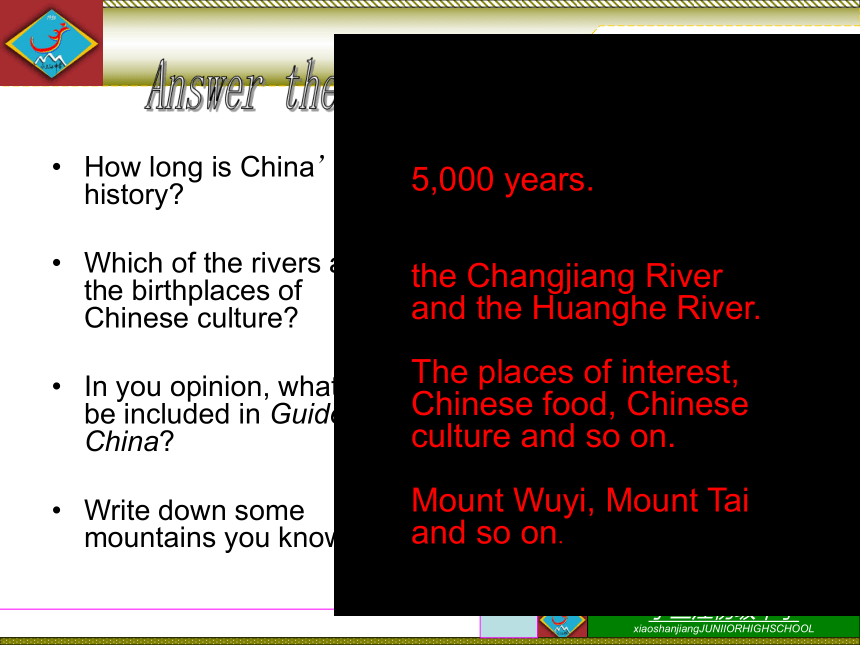
文档简介
(共42张PPT)
Unit
5
Knowing
about
China
Topic
1
How
much
do
you
know
about
China?
Section
A
A
map
of
China
A
tourism
map
of
China
null
the
Great
Wall
Have
you
ever
been
to...?
the
West
Lake
Have
you
ever
been
to...?
Mount
Huang
Have
you
ever
been
to...?
the
Huanghe
River
It
goes
through
nine
provinces
and
finally
joins
the
Bohai
Sea
Hulunbuir
Grassland
Hongkong
Have
you
ever
been
to...?
Taiwan
Have
you
ever
been
to...?
Macao
Have
you
ever
been
to...?
How
long
is
China’s
history?
Which
of
the
rivers
are
the
birthplaces
of
Chinese
culture?
In
you
opinion,
what
may
be
included
in
Guide
to
China?
Write
down
some
mountains
you
know.
Answer
the
following
questions
5,000
years.
the
Changjiang
River
and
the
Huanghe
River.
The
places
of
interest,
Chinese
food,
Chinese
culture
and
so
on.
Mount
Wuyi,
Mount
Tai
and
so
on.
Place
of
______in
China
mountain
some
beautiful
and
_______mountains
such
as
Mount
Tai,
Mount
______,
Mount
Song
and
Mount
Emei
river
a
great
_____
of
rivers
such
as
the
Changjiang
River,
the
______
one
and
the
Huanghe
River,
the
_____
longest
one
China
attracts
millions
of
______
from
all
over
the
world
each
year.
interest
famous
Huang
number
longest
second
tourists
It's
two
years
since
Mr.
and
Mrs.
Green
came
to
China
.
Their
daughter,
Susanna,
has
just
come
to
China.
She
knows
very
little
about
China.
Susanna:
Mom,
how
much
do
you
know
about
China?
Mrs.
Green:
Just
a
little.
China
is
a
great
country
that
has
about
5,000
years
of
history.
There
are
many
places
of
interest
which
attract
many
tourists
from
all
over
the
world
every
year.
Susanna:
Is
that
so?
Are
there
any
beautiful
mountains?
Mrs.
Green:
Yes.
And
some
of
them
are
famous,
such
as
Mount
Tai,
Mount
Huang,
Mount
Song
and
Mount
Emei.
Susanna:
What
about
rivers?
Mrs.
Green:
There
are
a
great
number
of
rivers
in
China.
Among
them
the
Changjiang
River
is
the
longest
one
and
the
second
longest
one
is
the
Huanghe
River.
They're
the
birthplaces
of
Chinese
culture.
Susanna:
Anything
else?
Mrs.
Green:
Sorry.
That’s
all
I
know.
I
don't
know
much.
If
you
want
to
learn
more.
I
can
fetch
you
Guide
to
China.
It's
a
book
which
introduces
China
in
detail.
Susanna:
Thanks,Mom.
吸引
长江
发源地
去拿
引导,指导
Key
points:
1.It’s
two
years
since
Mrs.
Green
came
to
China.
点拨:It’s
+
时间段
since
+
从句(过去时)
---自从…以来,时间过去多久了,It’s还可以用It
has
been替换.
练习:a.自从他离开祖国到现在已经有两年半了。It’s
_____
__
____
years
since
he
______
his
left
motherland.
b.自从最后一次见面到现在已经过去很久了。It
_____
______
a
long
time
since
I
met
him
____
_____
time.
two
and
a
half
since
has
been
the
last
Key
points:
2.There
are
many
places
of
interest
which
attract
millions
of
tourists
from
all
over
the
world
every
year.
attract
(v.)---吸引,使喜爱
链接:attraction(
词)
---爱慕,吸引;
attractive(
词)---英俊的,诱人的
练习:展览会吸引了成千上万的参观者
。
The
exhibition
has
_____
__
_________
__
.
attracted
thousands
of
visitors
Key
points:
3.There
are
a
great
number
of
rivers
in
China.
a
number
of
---许多;
后接可数名词的复数,谓语也用复数;
number前的修饰语有:
large,
small,
great,
good
区别:the
number
of…
---
…的数目(数量)”,后接名词的复数形式,谓语用单数。
练习:a.地上有很多很多蚂蚁。
There
_________
__________
ants
on
the
ground.
b.苹果的数量是40个。
_______
_______
_
the
apples
______
40.
are
a
large
number
of
The
number
of
is
Key
points:
4.Among
them,
the
Changjiang
River
is
the
longest
one
and
the
second
longest
is
the
Huanghe
River.
the
second
longest
---第二长,在形容词的最高级前可用序数词,意为“第……,最……”
练习:
a.那是第三项最有用的发明。
That
is
_____
_______
_______
_________
invention.
b.洛杉矶是美国第二大城市。
Los
Angeles
is
____
______
____
_____
in
the
USA.
the
third
most
useful
the
second
largest
city
Key
points:
5.If
you
want
to
learn
more,
I
can
fetch
you
Guide
to
China.
fetch
?
(去)拿来,请来,找来
take
→
拿走,带走
bring
←
取来,带来
fetch
sb.sth.
=
fetch
sth.
for
sb.---
给某人拿某物get
与fetch意思相同,但在口语中,get
比fetch更常用。
练习:a.请到楼上替我拿衣服。
Please
go
upstairs
and
________
the
coat.
b.我带着雨伞。I
forget
___
_the
umbrella
with
me.
c.不要忘记把你的作业带到学校来。
Don’t
forget
to
____
your
homework
to
school.
fetch
taking
bring
Attributive
Clause(定语从句)
China
is
a
great
country
that
has
about
5,000
years
of
history.
It's
a
book
which
introduces
China
in
detail.
先行词
先行词
关系代词作主语
关系代词作主语
定句从句
定句从句
China
is
a
great
country.
The
country
has
about
5000
years.
合并为一个句子
China
is
a
great
country
that/which
has
about
5000
years
定语从句.
概念:
在复合句中,修饰某一名词或代词的句子(从句).
先行词:
定语从句所修饰的词.
定语从句的位置:
放在先行词之后.
关系代词&关系副词:
引导定语从句的词.放在先行词和定语
从句之间,既起连接作用,同时代替先行词在定语从句充当一定成分
关系代词有:
that,
which,
who
whom,
whose
关系副词有:
when,
where,
why
that;which用法:
先行词是物时,
用which
或that引导,在从句中作主语或宾语.
eg:
These
are
the
trees
which/that
were
planted
last
year.
例句赏析~~~~
It’s
an
invention
which
/that
is
used
for
keeping
off
the
rain
.
It’s
the
Wall
that
/which
was
built
by
Chinese
people.
It’s
an
animal
that
/
which
has
big
nose.
Pair
work
A:
What
a
beautiful
place!
Where
is
it?
B:
It’s…
that/which
lies
in…
It’s
Mount
Tai
that/which
lies
in
Shangdong
Province.
A:
Have
you
ever
been
there
before?
B:
Yes,
I
have.
No,
I
haven’t.
Mount
Tai
Shandong
Province
Key
points:
6.It’s
Mount
Tai
that/which
lies
in
Shandong
Province.
点拨:lie
in/to/on
---
位于…
a.
in表示在范围之内
b.
to表示在范围之外
c.
on表示毗邻接壤,在…之畔
1.日本位于中国的东部。
Japan
______
the
east
of
China.
2.黑龙江位于中国的东北部。
Heilongjiang
______
the
northeast
of
China.
3.印度与中国的西南部接壤。
India
______
the
southwest
of
China.
lies
to
lies
in
lies
on
拓展:lie
(v.)
①
位,
坐落
②
躺,平躺,平卧
lie---lay---lain---lying
lie
①
(v.)
撒谎,说谎
lie---lied---lied---lying
②
(n.)
---谎言,谎话
tell
(sb.
)
a
lie
/
lies---___________
lay
(v.)
---下蛋,产卵
lay---laid---laid---laying
练习:
a.别总是对我撒谎!Don’t
always
______me!
b.玛丽喜欢在太阳底下躺着。
Mary
enjoys
______
on
her
back
in
the
sunshine.
c.这只母鸡每天下一只蛋。The
hen
______
an
egg
every
day.
d.下班后,他躺在床上一动不动。
After
work,
he
______
on
the
bed
without
moving.
A:
What
a
beautiful
place!
Where
is
it?
B:
It’s…
that/which
lies
in…
A:
Have
you
ever
been
there
before?
B:
Yes,
I
have.
/No,
I
haven’t.
Mount
Hua
Shanxi
Province
A:
What
a
beautiful
place!
Where
is
it?
B:
It’s…
that/which
lies
in…
It’s
Mount
Hua
that/which
lies
in
Shaanxi
Province.
A:
Have
you
ever
been
there
before?
B:
Yes,
I
have.
No,
I
haven’t.
Mount
Heng
Shanxi
Province
A:
What
a
beautiful
place!
Where
is
it?
B:
It’s…
that/which
lies
in…
A:
Have
you
ever
been
there
before?
B:
Yes,
I
have.
No,
I
haven’t.
Mount
Heng
Hunan
Province
A:
What
a
beautiful
place!
Where
is
it?
B:
It’s…
that/which
lies
in…
It’s
Mount
Heng
that/which
lies
in
Hunan
Province.
A:
Have
you
ever
been
there
before?
B:
Yes,
I
have.
No,
I
haven’t.
Mount
Song
Henan
Province
A:
What
a
beautiful
place!
Where
is
it?
B:
It’s…
that/which
lies
in…
It’s
Mount
Song
that/which
lies
in
Henan
Province.
A:
Have
you
ever
been
there
before?
B:
Yes,
I
have.
No,
I
haven’t.
3.
work
alone
Listen
to
the
passage
and
fill
in
the
blank.
Summary
重点词汇:attract;
fetch;
introduce;province
重点短语:
a
great
number
of;
lie
in...;
the
birthplace
of
Chinese
culture;in
detail
重点句型:
1.It's
two
years
since
Mr.
and
Mrs.
Green
came
to
China
.
2.China
is
a
great
country
that
has
about
5,000
years
of
history.
3.There
are
many
places
of
interest
which
attract
many
tourists
from
all
over
the
world
every
year.
4.It's
a
book
which
introduces
China
in
detail.
1.
My
parents
live
in
a
house__________
is
more
than
100
years
old.
which/that
2.
Kevin
is
reading
a
book
__________
is
too
difficult
for
him.
which/that
Excersice
下列情况只能用that
序数词或最高级adj修饰先行词时
all,
everything,
nobody
等不定代词作先行词时
5.
Is
there
anything
________
you
want
to
buy
in
the
town.
6.All
______
we
can
do
is
to
study
hard.
7.
The
first
one
_____
stands
up
is
a
little
boy.
that
that
that
将下列两句话合并成一句.
1.
I
can’t
find
the
book.
That's
about
China.
I
can’t
find
the
book
that
is
about
China.
2.
The
girl
is
my
sister.
The
girl
is
standing
on
the
stage.
The
girl
who/that
is
standing
on
the
stage
is
my
sister.
3.
The
West
Lake
lies
in
Hangzhou.
The
West
Lake
is
one
of
the
most
famous
lakes
in
China.
The
West
Lake
which
lies
in
Hangzhou
is
one
of
the
most
famous
lakes
in
China..
4.
The
cat
is
mine.
The
cat
is
playing
with
a
ball.
The
cat
that
is
playing
with
a
ball
is
mine.
1.
who指人,作主语或宾语
(作宾语可省略)
2.
whom指人,作宾语
(作宾语可省略,
如介词提前则不能省)
3.
which
指物,作主语或宾语
(作宾语可
省略,如介词提前则不能省)
4.
that
指人/物,作主语或宾语
(作宾语
可省略)
Thank
you
for
listening!
Unit
5
Knowing
about
China
Topic
1
How
much
do
you
know
about
China?
Section
A
A
map
of
China
A
tourism
map
of
China
null
the
Great
Wall
Have
you
ever
been
to...?
the
West
Lake
Have
you
ever
been
to...?
Mount
Huang
Have
you
ever
been
to...?
the
Huanghe
River
It
goes
through
nine
provinces
and
finally
joins
the
Bohai
Sea
Hulunbuir
Grassland
Hongkong
Have
you
ever
been
to...?
Taiwan
Have
you
ever
been
to...?
Macao
Have
you
ever
been
to...?
How
long
is
China’s
history?
Which
of
the
rivers
are
the
birthplaces
of
Chinese
culture?
In
you
opinion,
what
may
be
included
in
Guide
to
China?
Write
down
some
mountains
you
know.
Answer
the
following
questions
5,000
years.
the
Changjiang
River
and
the
Huanghe
River.
The
places
of
interest,
Chinese
food,
Chinese
culture
and
so
on.
Mount
Wuyi,
Mount
Tai
and
so
on.
Place
of
______in
China
mountain
some
beautiful
and
_______mountains
such
as
Mount
Tai,
Mount
______,
Mount
Song
and
Mount
Emei
river
a
great
_____
of
rivers
such
as
the
Changjiang
River,
the
______
one
and
the
Huanghe
River,
the
_____
longest
one
China
attracts
millions
of
______
from
all
over
the
world
each
year.
interest
famous
Huang
number
longest
second
tourists
It's
two
years
since
Mr.
and
Mrs.
Green
came
to
China
.
Their
daughter,
Susanna,
has
just
come
to
China.
She
knows
very
little
about
China.
Susanna:
Mom,
how
much
do
you
know
about
China?
Mrs.
Green:
Just
a
little.
China
is
a
great
country
that
has
about
5,000
years
of
history.
There
are
many
places
of
interest
which
attract
many
tourists
from
all
over
the
world
every
year.
Susanna:
Is
that
so?
Are
there
any
beautiful
mountains?
Mrs.
Green:
Yes.
And
some
of
them
are
famous,
such
as
Mount
Tai,
Mount
Huang,
Mount
Song
and
Mount
Emei.
Susanna:
What
about
rivers?
Mrs.
Green:
There
are
a
great
number
of
rivers
in
China.
Among
them
the
Changjiang
River
is
the
longest
one
and
the
second
longest
one
is
the
Huanghe
River.
They're
the
birthplaces
of
Chinese
culture.
Susanna:
Anything
else?
Mrs.
Green:
Sorry.
That’s
all
I
know.
I
don't
know
much.
If
you
want
to
learn
more.
I
can
fetch
you
Guide
to
China.
It's
a
book
which
introduces
China
in
detail.
Susanna:
Thanks,Mom.
吸引
长江
发源地
去拿
引导,指导
Key
points:
1.It’s
two
years
since
Mrs.
Green
came
to
China.
点拨:It’s
+
时间段
since
+
从句(过去时)
---自从…以来,时间过去多久了,It’s还可以用It
has
been替换.
练习:a.自从他离开祖国到现在已经有两年半了。It’s
_____
__
____
years
since
he
______
his
left
motherland.
b.自从最后一次见面到现在已经过去很久了。It
_____
______
a
long
time
since
I
met
him
____
_____
time.
two
and
a
half
since
has
been
the
last
Key
points:
2.There
are
many
places
of
interest
which
attract
millions
of
tourists
from
all
over
the
world
every
year.
attract
(v.)---吸引,使喜爱
链接:attraction(
词)
---爱慕,吸引;
attractive(
词)---英俊的,诱人的
练习:展览会吸引了成千上万的参观者
。
The
exhibition
has
_____
__
_________
__
.
attracted
thousands
of
visitors
Key
points:
3.There
are
a
great
number
of
rivers
in
China.
a
number
of
---许多;
后接可数名词的复数,谓语也用复数;
number前的修饰语有:
large,
small,
great,
good
区别:the
number
of…
---
…的数目(数量)”,后接名词的复数形式,谓语用单数。
练习:a.地上有很多很多蚂蚁。
There
_________
__________
ants
on
the
ground.
b.苹果的数量是40个。
_______
_______
_
the
apples
______
40.
are
a
large
number
of
The
number
of
is
Key
points:
4.Among
them,
the
Changjiang
River
is
the
longest
one
and
the
second
longest
is
the
Huanghe
River.
the
second
longest
---第二长,在形容词的最高级前可用序数词,意为“第……,最……”
练习:
a.那是第三项最有用的发明。
That
is
_____
_______
_______
_________
invention.
b.洛杉矶是美国第二大城市。
Los
Angeles
is
____
______
____
_____
in
the
USA.
the
third
most
useful
the
second
largest
city
Key
points:
5.If
you
want
to
learn
more,
I
can
fetch
you
Guide
to
China.
fetch
?
(去)拿来,请来,找来
take
→
拿走,带走
bring
←
取来,带来
fetch
sb.sth.
=
fetch
sth.
for
sb.---
给某人拿某物get
与fetch意思相同,但在口语中,get
比fetch更常用。
练习:a.请到楼上替我拿衣服。
Please
go
upstairs
and
________
the
coat.
b.我带着雨伞。I
forget
___
_the
umbrella
with
me.
c.不要忘记把你的作业带到学校来。
Don’t
forget
to
____
your
homework
to
school.
fetch
taking
bring
Attributive
Clause(定语从句)
China
is
a
great
country
that
has
about
5,000
years
of
history.
It's
a
book
which
introduces
China
in
detail.
先行词
先行词
关系代词作主语
关系代词作主语
定句从句
定句从句
China
is
a
great
country.
The
country
has
about
5000
years.
合并为一个句子
China
is
a
great
country
that/which
has
about
5000
years
定语从句.
概念:
在复合句中,修饰某一名词或代词的句子(从句).
先行词:
定语从句所修饰的词.
定语从句的位置:
放在先行词之后.
关系代词&关系副词:
引导定语从句的词.放在先行词和定语
从句之间,既起连接作用,同时代替先行词在定语从句充当一定成分
关系代词有:
that,
which,
who
whom,
whose
关系副词有:
when,
where,
why
that;which用法:
先行词是物时,
用which
或that引导,在从句中作主语或宾语.
eg:
These
are
the
trees
which/that
were
planted
last
year.
例句赏析~~~~
It’s
an
invention
which
/that
is
used
for
keeping
off
the
rain
.
It’s
the
Wall
that
/which
was
built
by
Chinese
people.
It’s
an
animal
that
/
which
has
big
nose.
Pair
work
A:
What
a
beautiful
place!
Where
is
it?
B:
It’s…
that/which
lies
in…
It’s
Mount
Tai
that/which
lies
in
Shangdong
Province.
A:
Have
you
ever
been
there
before?
B:
Yes,
I
have.
No,
I
haven’t.
Mount
Tai
Shandong
Province
Key
points:
6.It’s
Mount
Tai
that/which
lies
in
Shandong
Province.
点拨:lie
in/to/on
---
位于…
a.
in表示在范围之内
b.
to表示在范围之外
c.
on表示毗邻接壤,在…之畔
1.日本位于中国的东部。
Japan
______
the
east
of
China.
2.黑龙江位于中国的东北部。
Heilongjiang
______
the
northeast
of
China.
3.印度与中国的西南部接壤。
India
______
the
southwest
of
China.
lies
to
lies
in
lies
on
拓展:lie
(v.)
①
位,
坐落
②
躺,平躺,平卧
lie---lay---lain---lying
lie
①
(v.)
撒谎,说谎
lie---lied---lied---lying
②
(n.)
---谎言,谎话
tell
(sb.
)
a
lie
/
lies---___________
lay
(v.)
---下蛋,产卵
lay---laid---laid---laying
练习:
a.别总是对我撒谎!Don’t
always
______me!
b.玛丽喜欢在太阳底下躺着。
Mary
enjoys
______
on
her
back
in
the
sunshine.
c.这只母鸡每天下一只蛋。The
hen
______
an
egg
every
day.
d.下班后,他躺在床上一动不动。
After
work,
he
______
on
the
bed
without
moving.
A:
What
a
beautiful
place!
Where
is
it?
B:
It’s…
that/which
lies
in…
A:
Have
you
ever
been
there
before?
B:
Yes,
I
have.
/No,
I
haven’t.
Mount
Hua
Shanxi
Province
A:
What
a
beautiful
place!
Where
is
it?
B:
It’s…
that/which
lies
in…
It’s
Mount
Hua
that/which
lies
in
Shaanxi
Province.
A:
Have
you
ever
been
there
before?
B:
Yes,
I
have.
No,
I
haven’t.
Mount
Heng
Shanxi
Province
A:
What
a
beautiful
place!
Where
is
it?
B:
It’s…
that/which
lies
in…
A:
Have
you
ever
been
there
before?
B:
Yes,
I
have.
No,
I
haven’t.
Mount
Heng
Hunan
Province
A:
What
a
beautiful
place!
Where
is
it?
B:
It’s…
that/which
lies
in…
It’s
Mount
Heng
that/which
lies
in
Hunan
Province.
A:
Have
you
ever
been
there
before?
B:
Yes,
I
have.
No,
I
haven’t.
Mount
Song
Henan
Province
A:
What
a
beautiful
place!
Where
is
it?
B:
It’s…
that/which
lies
in…
It’s
Mount
Song
that/which
lies
in
Henan
Province.
A:
Have
you
ever
been
there
before?
B:
Yes,
I
have.
No,
I
haven’t.
3.
work
alone
Listen
to
the
passage
and
fill
in
the
blank.
Summary
重点词汇:attract;
fetch;
introduce;province
重点短语:
a
great
number
of;
lie
in...;
the
birthplace
of
Chinese
culture;in
detail
重点句型:
1.It's
two
years
since
Mr.
and
Mrs.
Green
came
to
China
.
2.China
is
a
great
country
that
has
about
5,000
years
of
history.
3.There
are
many
places
of
interest
which
attract
many
tourists
from
all
over
the
world
every
year.
4.It's
a
book
which
introduces
China
in
detail.
1.
My
parents
live
in
a
house__________
is
more
than
100
years
old.
which/that
2.
Kevin
is
reading
a
book
__________
is
too
difficult
for
him.
which/that
Excersice
下列情况只能用that
序数词或最高级adj修饰先行词时
all,
everything,
nobody
等不定代词作先行词时
5.
Is
there
anything
________
you
want
to
buy
in
the
town.
6.All
______
we
can
do
is
to
study
hard.
7.
The
first
one
_____
stands
up
is
a
little
boy.
that
that
that
将下列两句话合并成一句.
1.
I
can’t
find
the
book.
That's
about
China.
I
can’t
find
the
book
that
is
about
China.
2.
The
girl
is
my
sister.
The
girl
is
standing
on
the
stage.
The
girl
who/that
is
standing
on
the
stage
is
my
sister.
3.
The
West
Lake
lies
in
Hangzhou.
The
West
Lake
is
one
of
the
most
famous
lakes
in
China.
The
West
Lake
which
lies
in
Hangzhou
is
one
of
the
most
famous
lakes
in
China..
4.
The
cat
is
mine.
The
cat
is
playing
with
a
ball.
The
cat
that
is
playing
with
a
ball
is
mine.
1.
who指人,作主语或宾语
(作宾语可省略)
2.
whom指人,作宾语
(作宾语可省略,
如介词提前则不能省)
3.
which
指物,作主语或宾语
(作宾语可
省略,如介词提前则不能省)
4.
that
指人/物,作主语或宾语
(作宾语
可省略)
Thank
you
for
listening!
同课章节目录
- Unit 5 China and the world
- Topic 1 China attracts millions of tourists from a
- Topic 2 He is really the pride of China.
- Topic 3 Now it is a symbol of England.
- Unit 6 Entertainment and Friendship.
- Topic 1 I would rather watch sports shows than tho
- Topic 2 Who is your favorite character in literatu
- Topic 3 I will remember our friendship forever.
